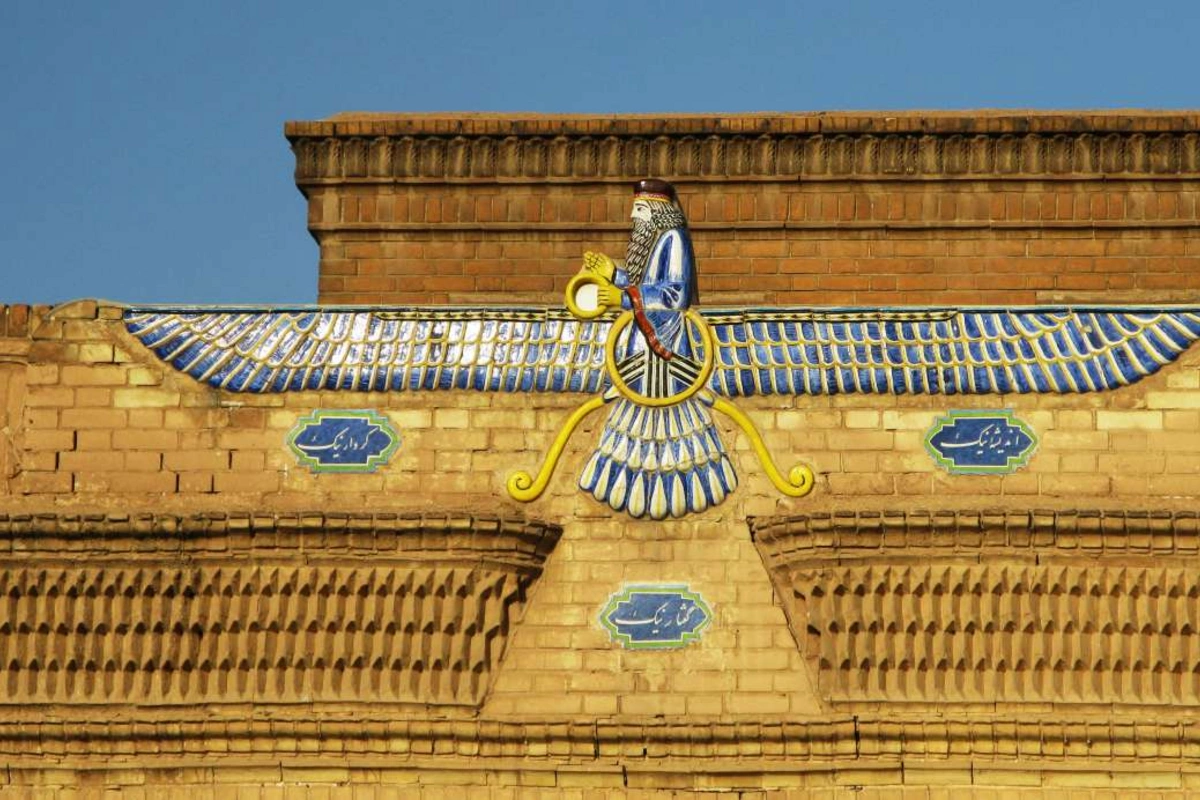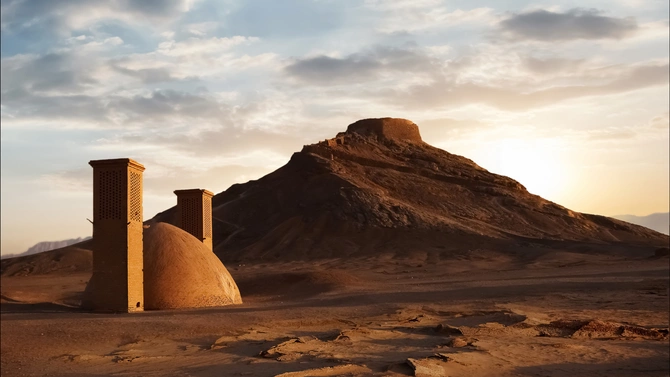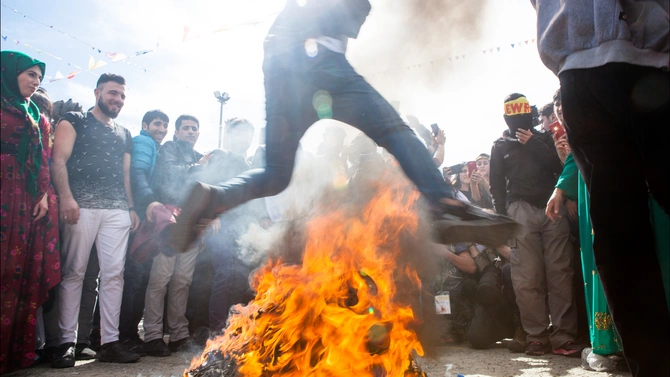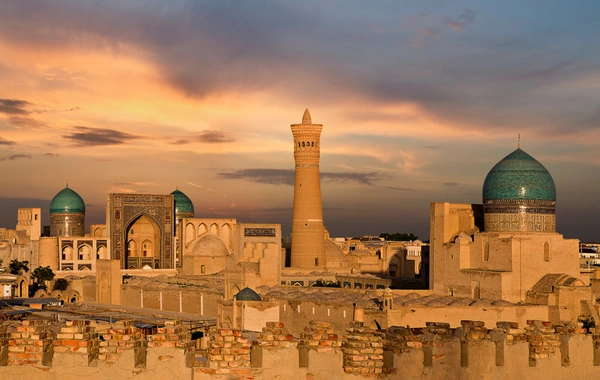
Zoroastrianism pioneered monotheism, inspired Iran’s great empires and - over two millennia later - remains a living religion, notably amongst the #Parsi communities of India and beyond. However, it has also left a remarkable cultural imprint on the whole of the Caspian region. And today, its ecologically aligned principles look ever more relevant in answering the needs of contemporary society.
Faravahar, the most recognizable symbol of Zoroastrianism, is often used to represent ancient Persia more generally. Image: Homo Cosmicos/Shutterstock
Photos of women in long black chadors and clerics with long beards often typify the images with which Iran is portrayed to Western audiences, leading many to equate the country with radical Islam and sharia law. Far less known is the fact that Iran is also the birthplace of one of the world’s oldest monotheistic religions, predating Judaism and other Abrahamic religions, as well as Buddhism. That religion is Zoroastrianism, rooted in the teachings of prophet Zoroaster (Zardosht), whose name is familiar to Westerners through Nietzche’s famous book, Also Sprach Zarathustra (Thus Spoke Zarathustra). Dualistic dichotomies such as good versus evil, and heaven versus hell, have important roles in the faith, centred around Ahura Mazda, the all-good Lord of Wisdom and the supreme creator of all beings. Even though its power is not equivalent to that of Ahura Mazda, a devil figure exists in the form of Angra Mainyu (known as Ahriman in contemporary Farsi), symbolizing evil forces. Angra Mainyu controls druj (lies and deceit) in contrast with asha (truth and righteousness), which is upheld by Ahura Mazda. Zoroastrians strive for the ultimate victory of good against evil, believing in the power and agency of human beings to choose between them.

Zoroastrian places of worship are known as Atashgah or Atashkadeh, often translated as ‘Fire Temples’ as each contains an eternal flame that burns continuously. However, contrary to the common stereotype among some Muslims and Westerners, Zoroastrians do not actually worship fire. The central importance of the fire comes from its close association with asha, symbolized by light and warmth. Unlike priests or mullahs in churches or mosques, Zoroastrian priests do not preach or give sermons. Instead, they play a crucial role in ceremonies where sandalwood or similar offerings are fed to the flames.

A particularly unusual feature of traditional Zoroastrian practice was that of ‘sky burial.’ To not dishonour the sacred natural elements (earth, fire, water and air), Zoroastrians would avoid burying or burning the bodies of their loved ones after their death. Instead, the body would be left at a remote dakhma (tower of silence) to return to nature by being exposed to sunshine and birds of prey. Dakhma usage was banned in Iran after the 1979 Revolution, though a few of the most magnificent are preserved as archaeological curiosities.[1]

Though it was once the state religion of ancient Iranian empires, Zoroastrianism lost its political and spiritual dominance in Iran after the Islamic conquest of the 8th century. In contemporary Iran, the faith retains constitutional recognition and parliamentary representation, but the country’s Zoroastrian community now counts barely 25,000 adherents according to the latest census, most living in the provinces of Yazd and Kerman. Low birth rates and the fact that Zoroastrianism is traditionally seen as an inherited identity passed on by families means that numbers continue to dwindle. Nonetheless, some important temples remain. In a hidden corner of rural Yazd is a celebrated Zoroastrian shrine named Chak-Chak or Pir-e Sabz (Green Shrine), dedicated to the Sassanid Princess Nikbanu, which welcomes thousands of pilgrims from all over the country in mid-June each year.

Zoroastrians living outside of Iran (around 125,000) now significantly outnumber those in the country. Indeed, of the roughly 160 active Zoroastrian temples around the world, the majority are now in India. Many Zoroastrians abroad, typically known as the ‘Parsi’[2] community, trace their roots to Iranians who originally migrated to India.

The first wave of such immigrants came following the Islamic conquest of the 7th century, though there have been several more throughout history. Parsis now have their own small diasporas in Western countries, including Canada and the United States. There are fire temples in the Caucasus in Tbilisi and near Baku[3], and it is no coincidence that Azerbaijan is known as ‘the land of fire,’ though the temples there are now touristic curiosities rather than active places of worship.
Despite the small numbers of the religion’s formal practitioners, Zoroastrianism has maintained a disproportionately significant global presence, notably through its imprint on other cultures.
A key example is Nowruz, the ‘new year’ celebration of the spring equinox. This is one of the year’s most important holidays in Iran, Central Asia, Azerbaijan and beyond, yet it has its roots in Zoroastrianism. During the period leading up to Nowruz, families lay a special commemorative table – in Iran called haftsin – with seven items starting with the Persian letter S (sin). These are now typically accompanied by various other non-Zoroastrian items, including perhaps a Quran for Muslim families or books of Persian poetry for others. However, the original ‘S’ sins are directly linked with nature, underlining Zoroastrianism’s heritage as an ‘ecological religion.’

Similarly, the ‘Scarlet Wednesday’ (Chaharshanbeh Suri) ceremonies, held each year on the last Wednesday before Nowruz, are centred around nature, particularly fire. From Tehran, Baku and Diyarbakir to Los Angeles and Toronto, men, women, and children leap over a fire, symbolically casting illness, sadness, and suffering into the flames while embracing joy and power through the fire’s light and warmth[4].

Other symbols taken from Zoroastrianism are globally visible such as at Iranian restaurants in the West, which often use the sacred Faravahar (winged messenger) as an icon on their frontages or menus. There are also Kurdish music groups and publishing houses in Turkey called Avesta, a name taken from the Zoroastrian religious book.
What makes thousands of diaspora Iranians and Turkish Kurds proudly embrace these symbols despite having Muslim names and non-Zoroastrian family backgrounds? The answer lies in the complexity of contemporary ethnic, national, and religious identities in the region. In almost any context, difference is at the core of any identity formation, separating the ‘self’ from the ‘other,’ the ‘us’ from the ‘them.’ Difference, in this context, can be biological, linguistic, religious, political, or historical. Recognizing, defining, and reproducing differences is an integral part of maintaining individual self-identity, as well as collective identity formations, including narratives of ethnicity and nationality. Diaspora Iranians in Western countries who embrace and reclaim elements of Zoroastrian heritage underline at least two differences. One is their difference from the local majority, predominantly seen as white and Christian. The other is their difference from the dominant representation of Iranians, which, as recalled at the beginning of this article, is often seen as exaggeratedly Islamic.

Indeed, considering the impacts of the post-9/11 image of Islam and the significant dissent of many diaspora Iranians from the Islamic government’s policies, the pride in embracing more ancient religious symbols is far from surprising. Well predating the September 11 attacks, even before Iran’s 1979 Islamic Revolution, secular Persian nationalist narratives celebrated the country’s Zoroastrian heritage, underlining historical differences with neighbouring peoples such as Arabs, Turks, and Russians.
It is interesting to note that the contemporary celebration of Zoroastrian heritage is not limited to Iranians. Even though Turkey’s Kurds are mostly Muslims, some contemporary Kurdish nationalist narratives have embraced and politicized the Zoroastrian heritage. For example, every year, the Kurdish-populated city of Diyarbakir hosts large, collective Nowruz celebrations. Unlike those in Iran and the rest of the region, Diyarbakir’s Nowruz celebrations are often platforms for prominent political figures. In their speeches, the boundaries between ancient Iranian Zoroastrian mythology and contemporary Turkish politics get blurred. Similarly, Iraqi Kurdistan witnessed a revival of Zoroastrianism after 2015. Interpreted as a reaction against the impacts of the ISIS attacks and occupation, this trend of Kurdish conversions to Zoroastrianism has been called ‘neo-Zoroastrianism’ by some scholars.

While there is power in reclaiming ancestral cultural heritages, this contemporary politicization of the ancient faith can occasionally create tension. In 2016, the Federation of Zoroastrian Associations of North America contacted the Turkish Embassies in Canada and the United States to express concerns about discourses linking their religion to illegal Kurdish organizations which use violence.
Zoroastrianism long predates modern nationalism and associated political conflicts. The religion’s cultural inheritance still resonates in a large geographical area from Georgia to India, reminding us of common historical ties across the borders of today’s nation-states. Is it possible to celebrate our differences while simultaneously embracing our cultural connections? Zoroastrianism’s underlying principles of respect for nature's elements and humankind might give us an avenue for such a possibility.
Regardless of our differences, we can all learn from this ancient religion’s emphasis on ‘Good Thoughts, Good Words, and Good Deeds.’ Indeed, in this time of increasing uncertainty and grief, a Zoroastrian-style faith in the eventual triumph of good over evil can provide us with a sense of inspiration that has helped people through more than two millennia.
[1] Some Zoroastrian sky burials continued in Mumbai, India well into the 21st century
[2] From Farsi ie Persian
[3] The temple at Surakhany is now a museum and was previously a Hindu place of worship following in the tradition of the Jawalamukhi Devi Temple. However, a spontaneously burning source of methane on the same site was in all probability the site of a Zoroastrian temple long before that.
[4] Traditionally the old Persian day technically started at sunset so the fire jumping is often on a Tuesday night by the modern calendar, not a Wednesday despite the name
Share on social media
